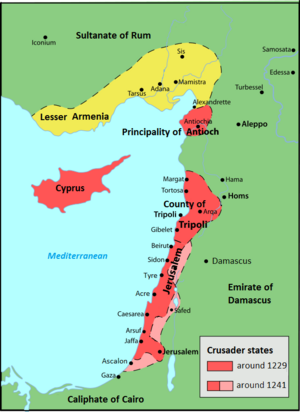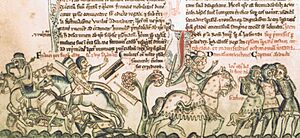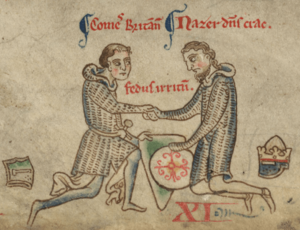Barons' Crusade facts for kids
Quick facts for kids Barons' Crusade |
|||||||||
|---|---|---|---|---|---|---|---|---|---|
| Part of the Crusades | |||||||||
 Map depicting gains made by the crusade Red: Crusader states in 1239; Pink: territory acquired in 1239–41 |
|||||||||
|
|||||||||
| Belligerents | |||||||||
| Kingdom of Jerusalem French and Navarre crusaders English crusaders County of Habsburg Military orders
|
Ayyubids of Egypt |
||||||||
| Commanders and leaders | |||||||||
Walter of Brienne
|
As-Salih Ismail
As-Salih Ayyub |
||||||||
The Barons' Crusade (1239–1241) was a journey by European knights to the Holy Land. It's also called the Crusade of 1239. This crusade was very successful in gaining land. In fact, it was the most successful crusade for getting back territory since the First Crusade.
Pope Gregory IX asked for this crusade. He wanted to unite all Christians to help. Crusaders came from France, England, and Hungary. Even though they didn't win many big battles, they were smart. They used diplomacy to make two rival Muslim groups, the Ayyubid dynasty of Damascus and Egypt, fight each other. This helped the crusaders gain even more land than Frederick II had won earlier. For a few years, the Barons' Crusade made the Kingdom of Jerusalem the biggest it had been since 1187.
This crusade is sometimes seen as two separate parts. The first part was led by King Theobald I of Navarre, starting in 1239. The second part was led by Richard of Cornwall, who arrived in 1240 after Theobald left.
Contents
Why Did the Barons' Crusade Happen?
At the end of the Sixth Crusade in 1229, Frederick II and the Muslim leader Al-Kamil signed a 10-year peace agreement. This treaty gave Christians control of Jerusalem, Nazareth, Sidon, Jaffa, and Bethlehem. But this agreement was going to end in 1239. This meant Christian control of these lands was in danger.
Also, many local Christian leaders didn't like Frederick II. They felt he left them unprotected. He also tried to take control of the Holy Land for himself, instead of giving it back to the local Christian lords. So, in 1234, Pope Gregory IX announced a new crusade. He wanted it to arrive in the Holy Land by 1239 to keep the Christian lands safe.
The Pope wanted everyone to support this crusade. He asked all Christians to attend special sermons. He wanted them to pray for success and donate money. This plan worked better in some places than others. Knights and nobles in England and France first supported the Pope's idea.
The Pope also tried to change the crusade's goal. He wanted some crusaders to go to Constantinople instead. He wanted them to fight other Christians who were trying to take over the Latin Empire. But this plan mostly failed. Most crusaders still wanted to go to the Holy Land.
The Crusade Begins
King Theobald I of Navarre gathered many important European nobles in Lyon. These included Hugh IV, Duke of Burgundy, Amaury VI of Montfort, and Peter I, Duke of Brittany. They also had many other counts and knights. Theobald's main army had about 1,500 knights. A few hundred of these were from Navarre.
They left France in August 1239. Most sailed from Marseilles. A smaller group left from ports in southern Italy. Theobald arrived in Acre on September 1st. Other crusaders who were separated by a storm soon joined him. Local Christian leaders met them there. Some crusaders from Cyprus also joined.
Theobald spent some time in Acre. He even wrote a poem to his wife. Finally, on November 2nd, the army marched to Ascalon. There were about 4,000 knights in total. More than half were local lords and knights from military orders. They planned to rebuild a castle there that Saladin had destroyed years ago.
Two days into the march, Peter of Brittany and his helper Raoul de Soissons went on a separate mission. They split their forces. They waited to ambush a Muslim trade group heading to Damascus. Peter's group fought the Muslims. They won, taking captives and supplies.
Battle at Gaza and Losing Jerusalem

Peter's small victory was soon forgotten. On November 12, 1239, the army reached Jaffa. A group of knights wanted to go on their own raid. This group included Henry II, Count of Bar, Amaury VI of Montfort, and Hugh IV, Duke of Burgundy. Four important local lords also joined them.
This group had about 400 to 600 knights. They left the main army, even though Theobald and the leaders of the military orders (like the Knights Templar) told them not to. They rode all night. The next day, November 13, they fought an Egyptian army at the Battle of Gaza.
The crusader group was badly defeated. Henry of Bar was killed. Amaury of Montfort was one of several hundred crusaders taken prisoner. The army then marched back to Acre.
About a month later, a Muslim leader named an-Nasir Dawud marched on Jerusalem. Jerusalem was not well defended. After a month, the Christian soldiers in the Tower of David gave up. They were allowed to leave safely for Acre. Jerusalem was back in Muslim hands for the first time since 1229.
New Land for Christians

After the defeat at Gaza and losing Jerusalem, a civil war started among the Muslim Ayyubid dynasty. This was good news for the Christians.
Theobald talked with the warring Muslim leaders of Damascus and Egypt. He made a deal with Ismail of Damascus. This deal was against Ayyub of Egypt and Dawud of Transjordan.
Through this deal, the Kingdom of Jerusalem got back Jerusalem itself. They also got Bethlehem, Nazareth, and most of the Galilee region. This included many Templar castles like Beaufort and Saphet. Ismail's deal gave the crusaders land that wasn't really his to give. It was more like a promise that they could take Dawud's lands.
This deal was not popular with Ismail's own people. A famous preacher even spoke out against it. Ismail had him arrested. The Muslim soldiers at Beaufort Castle also refused to give it to the Christians. Ismail himself had to attack the castle to get it for the crusaders.
Meanwhile, the crusaders started taking Dawud's lands. They began rebuilding Ascalon. They raided the Jordan valley. They took back Jerusalem. They also attacked Nablus, but didn't capture it. This forced Dawud to make his own deal with Theobald in late summer 1240. This deal actually gave the Christians many of the lands Ismail had only promised.
Some old writings even say that all the land between the Jordan River and the Mediterranean Sea was returned to the crusaders. Theobald and Peter of Brittany left for Europe in September 1240. They left before Richard of Cornwall arrived. They didn't want to be part of any more arguments about who was in charge. Theobald brought back a special rose from Damascus to Europe.
Richard of Cornwall's Arrival
On June 10, 1240, Richard, 1st Earl of Cornwall left England. He had a smaller group of crusaders. This group included about a dozen English lords and several hundred knights. They arrived in Acre on October 8. Simon de Montfort, whose older brother was captured, also joined this group.
Richard and his group did not fight any battles. But they did finish the peace talks with the Muslim leaders. These talks had been started by Theobald a few months earlier. They continued rebuilding Ascalon castle. Richard gave control of the castle to Frederick II's agent in Jerusalem.
On April 23, 1241, they exchanged Muslim prisoners for Christian captives. This included Simon's older brother, Amaury. He had been captured during Henry of Bar's bad raid at Gaza a year and a half earlier. They also moved the bodies of those killed in that battle and buried them in Ascalon. Richard finished his work and left Acre for England on May 3, 1241.
What Happened Next?
The Barons' Crusade made the Kingdom of Jerusalem the biggest it had been since 1187. But these gains didn't last long. On July 15, 1244, Jerusalem was not just captured again. It was destroyed. Christians there were killed by soldiers from northern Syria. These soldiers were new allies of the Sultan of Egypt.
A few months later, in October, the Sultan and his allies won a major battle. This was the Battle of La Forbie. This battle greatly weakened Christian military power in the Holy Land for good.
Baldwin of Courtenay's Crusade to Tzurulum
A small, separate group of crusaders listened to Pope Gregory's call. They went to defend the Latin Empire in Constantinople. In July 1239, Baldwin of Courtenay, the young heir to the Latin Empire, traveled to Constantinople. He had a small army.
Baldwin arrived in Constantinople in the winter of 1239. He was crowned emperor around Easter 1240. After that, he launched his own crusade. Baldwin attacked and captured Tzurulum. This was a stronghold about seventy-five miles west of Constantinople. Tzurulum was important because two main roads to Constantinople met there. Taking it made Constantinople safer.
However, this victory could not make up for losing two other fortresses. These were captured by another leader. Even with Tzurulum, the Latin Empire still needed help from Western Europe. It eventually fell apart in 1261.
Sources

